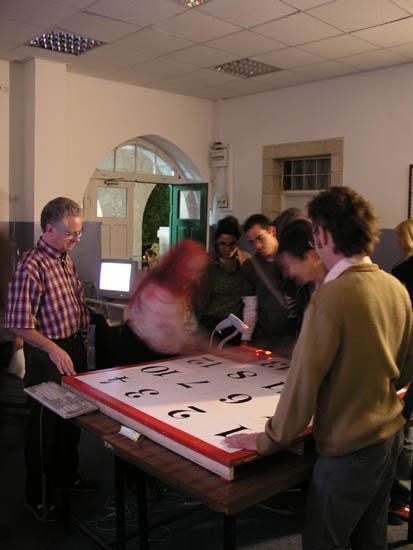
The Cadbury™ Revolutionary Study Room
Interactive Sound Installation
Elementary School Hall
This is a presentation of a new state-of-the-art learning device, which is the latest technology designed for elementary schools. You are invited to visit The Cadbury™ Revolutionary Study Room and to give the MOC-16™ a run. Be sure to equip your school with the latest development in the field of multi-dimensional thinking-development. Don’t let you children miss out the joy of exploring many dimensions.
- Brought to you by the caring people of Cadbury™.
"The Cadbury™ Revolutionary Study Room" is a sound-based installation conceived as a sophisticated and poignant criticism of the elements of control immanently embedded in our digital society and its deployment of codes and numbers. It utilizes the interaction of an audience engaged in play to constitute and influence the structure of a continuous electro-acoustic composition.
The interaction with the MOC-16™ is enjoyable, and re-creates the fun-infused learning experience familiar from early elementary-school period, or from our childhood's science fairs. Yet the naïve and nostalgic experience is diverted by allowing each [in]dividual to access only partial playing options, while preventing them from accessing other options, which were clearly available to other people.
The accessible options are determined [in]dividualy according to their ID number, their code.
The MOC-16™ consists of a game-panel, a corresponding electronic display, speakers playing sounds and a bar-code reader. The game panel is basically an enlarged model of an actual popular educational game, where one has to organize 15 movable cartridges numbered 1-15 inside a 16 cell matrix. The panel is digitally-wired to function as a control interface for the display, which mirrors the numerical arrangement of the physical panel. The panel is connected to a computer running a special program, built with the MAX/MSP software, which synchronizes and performs all the necessary digital operations.
Each of the 16 cells is assigned a song from an educational TV program, indicated by a label carrying the show title. The songs are played when their corresponding cell is turned ON (indicated by it being colored red). All the songs are being manipulated and twisted sonically, though they remain identifiable throughout most of the manipulations. The level of manipulations which a song undergoes is determined by the number assigned to its correlative cell at a given moment. The audience actually hears a continuous electro-acoustic piece composed entirely of manipulated sounds from educational children television programs.
In “idle” mode, when no one is “testing” the MOC-16™, all the cells are active and all the songs are mixed together. In order to initiate a “test”, the person has to hand in their ID, from which their ID number is being read by the bar-code reader. This action causes the activation of only four cells out of the 16, while the other songs fade-out. The activated songs are the ones with which the audience can now play – these are the songs to which they were allowed access. They cannot activate any other songs. They can move the cartridges as they wish, but only when they slid a new cartridge into one of the activated cells, they affect the sound of what they hear.
The MOC-16™ is presented as the new product to emerge from the laboratories of the Cadbury Corporation (the work was presented initially as part of Sala-manca’s “Heara 8” art event in Jerusalem, in a classroom inside an elementary school which was donated in the 19th century by the famous chocolate manufacturer, whose logo was proudly engraved over the building entrance). Because they are derived from the actual ID number, the playing options differ from person to person. Though the playing experience remains fun, the difference between people’s options constitutes a sense of segregation, and in the case of people who wish to hear songs they can’t access might lead to a feeling of resentment towards the arbitrary obtrusion of information.